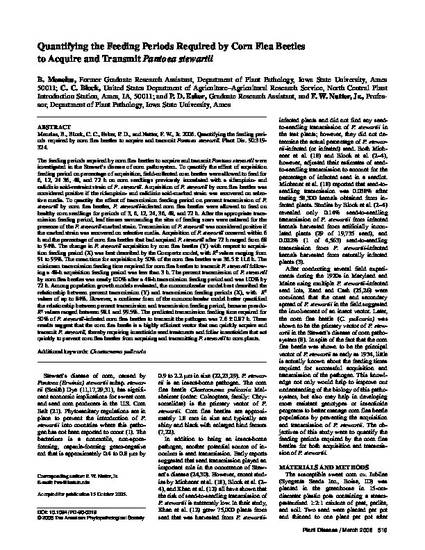
The feeding periods required by corn flea beetles to acquire and transmit Pantoea stewartii were investigated in the Stewart's disease of corn pathosystem. To quantify the effect of acquisition feeding period on percentage of acquisition, field-collected corn beetles were allowed to feed for 6, 12, 24 36, 48, and 72 h on corn seedlings previously inoculated with a rifampicin- and nalidixic acid-restraint strain of P. stewartii. Acquisition of P. stewartii by corn flea beetles was considered positive if the rifampicin- and nalidixic acid-marked strain was recovered on selective media. To quantity the effect of transmission feeding period on percent transmission of P. stewartii by corn flea beetles, P. stewartii- infested corn flea beetles were allowed to feed on healthy corn seedlings for periods of 3, 6, 12, 24, 36, 48, and 72 h. After the appropriate transmission feeding period, leaf tissues surrounding the sites of feeding scars were cultured for the presence of the P. stewartii-marked strain. Transmission of P. stewartii was considered positive if the marked strain was recovered on selective media. Acquisition of P. stewartii occurred within 6 h and the percentage of corn flea beetles that had acquired P. stewartii after 72 h ranged from 68 to 94%. The change in P. stewartiiacquisition by corn flea beetles (Y) with respect to acquisition feeding period (X) was best described by the Gompertz model, with R2 values ranging from 91 to 99%. The mean time for acquisition by 50% of the corn flea beetles was 36.5 ± 11.6 h. The minimum transmission feeding time required for corn flea beetles to transmit P. stewartii following a 48-h acquisition feeding period was less than 3 h. The percent transmission of P. stewartii by corn flea beetles was nearly 100% after a 48-h transmission feeding period and was 100% by 72 h. Among population growth models evaluated, the monomolecular model best described the relationship between percent transmission (Y) and transmission feeding periods (X), with R 2 values of up to 84%. However, a nonlinear form of the monomolecular model better quantified the relationship between percent transmission and transmission feeding period, because pseudo-R2 values ranged between 98.1 and 99.5%. The predicted transmission feeding time required for 50% of P. stewartii-infested corn flea beetles to transmit the pathogen was 7.6 ± 0.87 h. These results suggest that the corn flea beetle is a highly efficient vector that can quickly acquire and transmit P. stewartii, thereby requiring insecticide seed treatments and foliar insecticides that act quickly to prevent corn flea beetles from acquiring and transmitting P. stewartii to corn plants.
Available at: http://works.bepress.com/forrest_nutter/59/

This article is from Plant Disease 90 (2006): 319, doi:10.1094/PD-90-0319 .